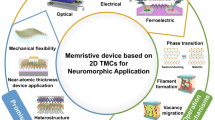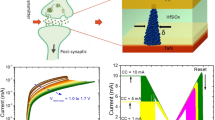Abstract
Memristors are memory-capable electronic components that consist of two terminals and a switching layer, whose resistance can be adjusted by an applied bias voltage. Two-dimensional (2D) materials with ultrathin layered structures are used as switching layers to overcome the limitations of traditional resistive materials in reducing the memristor sizes, demonstrating their potential in memory, flexible electronics, neuromorphic computing, and other related fields. Particularly, MoS2 is widely used as a representative 2D semiconductor, and the MoS2-based memristors have been intensively studied. In this review article, we have summarized the recent progress of MoS2-based memristors, including the fabrication process, device structure, device performance, switching mechanism, and synaptic applications. In addition, we also discussed the prospects and challenges for their future development.
Similar content being viewed by others
References
Strukov D B, Snider G S, Stewart D R, et al. The missing memristor found. Nature, 2008, 453: 80–83
Xia Q, Yang J J. Memristive crossbar arrays for brain-inspired computing. Nat Mater, 2019, 18: 309–323
Lee M J, Lee C B, Lee D, et al. A fast, high-endurance and scalable non-volatile memory device made from asymmetric Ta2O5−x/Ta2O2−x bilayer structures. Nat Mater, 2011, 10: 625–630
Yao P, Wu H, Gao B, et al. Fully hardware-implemented memristor convolutional neural network. Nature, 2020, 577: 641–646
Yang J J, Strukov D B, Stewart D R. Memristive devices for computing. Nat Nanotech, 2013, 8: 13–24
Prezioso M, Merrikh-Bayat F, Hoskins B D, et al. Training and operation of an integrated neuromorphic network based on metal-oxide memristors. Nature, 2015, 521: 61–64
Zidan M A, Strachan J P, Lu W D. The future of electronics based on memristive systems. Nat Electron, 2018, 1: 22–29
Ielmini D, Wong H S P. In-memory computing with resistive switching devices. Nat Electron, 2018, 1: 333–343
Lastras-Montaño M A, Cheng K T. Resistive random-access memory based on ratioed memristors. Nat Electron, 2018, 1: 466–472
Kumar S, Strachan J P, Williams R S. Chaotic dynamics in nanoscale NbO2 Mott memristors for analogue computing. Nature, 2017, 548: 318–321
Rehn D A, Reed E J. Memristors with distorted structures. Nat Mater, 2019, 18: 8–9
Wang Z, Joshi S, Savel’ev S E, et al. Memristors with diffusive dynamics as synaptic emulators for neuromorphic computing. Nat Mater, 2017, 16: 101–108
Sun K, Chen J, Yan X. The future of memristors: materials engineering and neural networks. Adv Funct Mater, 2017, 31: 2006773
Huh W, Lee D, Lee C H. Memristors based on 2D materials as an artificial synapse for neuromorphic electronics. Adv Mater, 2020, 32: 2002092
Shi T, Wang R, Wu Z, et al. A review of resistive switching devices: performance improvement, characterization, and applications. Small Struct, 2021, 2: 2000109
Ge R, Wu X, Kim M, et al. Atomristor: nonvolatile resistance switching in atomic sheets of transition metal dichalcogenides. Nano Lett, 2018, 18: 434–441
Kim M, Ge R, Wu X, et al. Zero-static power radio-frequency switches based on MoS2 atomristors. Nat Commun, 2018, 9: 2524
Lu X F, Zhang Y, Wang N, et al. Exploring low power and ultrafast memristor on p-type van der Waals SnS. Nano Lett, 2021, 21: 8800–8807
Li S, Pam M E, Li Y, et al. Wafer-scale 2D hafnium diselenide based memristor crossbar array for energy-efficient neural network hardware. Adv Mater, 2022, 34: 2103376
Ranganathan K, Fiegenbaum-Raz M, Ismach A. Large-scale and robust multifunctional vertically aligned MoS2 photo-memristors. Adv Funct Mater, 2020, 30: 2005718
Feng X, Li Y, Wang L, et al. A fully printed flexible MoS2 memristive artificial synapse with femtojoule switching energy. Adv Electron Mater, 2019, 5: 1900740
Yan X, Zhao Q, Chen A P, et al. Vacancy-induced synaptic behavior in 2D WS2 nanosheet-based memristor for low-power neuromorphic computing. Small, 2019, 15: 1901423
Sangwan V K, Jariwala D, Kim I S, et al. Gate-tunable memristive phenomena mediated by grain boundaries in single-layer MoS2. Nat Nanotech, 2015, 10: 403–406
Shi Y, Liang X, Yuan B, et al. Electronic synapses made of layered two-dimensional materials. Nat Electron, 2018, 1: 458–465
Lei P, Duan H, Qin L, et al. High-performance memristor based on 2D layered BiOI nanosheet for low-power artificial optoelectronic synapses. Adv Funct Mater, 2022, 32: 2201276
Splendiani A, Sun L, Zhang Y, et al. Emerging photoluminescence in monolayer MoS2. Nano Lett, 2010, 10: 1271–1275
Xu R, Jang H, Lee M H, et al. Vertical MoS2 double-layer memristor with electrochemical metallization as an atomic-scale synapse with switching thresholds approaching 100 mV. Nano Lett, 2019, 19: 2411–2417
Abnavi A, Ahmadi R, Hasani A, et al. Free-standing multilayer molybdenum disulfide memristor for brain-inspired neuro-morphic applications. ACS Appl Mater Interfaces, 2021, 13: 45843–45853
Wang M, Cai S, Pan C, et al. Robust memristors based on layered two-dimensional materials. Nat Electron, 2018, 1: 130–136
Zhu X, Li D, Liang X, et al. Ionic modulation and ionic coupling effects in MoS2 devices for neuromorphic computing. Nat Mater, 2019, 18: 141–148
Cheng P, Sun K, Hu Y H. Memristive behavior and ideal memristor of 1T Phase MoS2 nanosheets. Nano Lett, 2016, 16: 572–576
Tang B, Veluri H, Li Y, et al. Wafer-scale solution-processed 2D material analog resistive memory array for memory-based computing. Nat Commun, 2022, 13: 3037
Desai S B, Madhvapathy S R, Sachid A B, et al. MoS2 transistors with 1-nanometer gate lengths. Science, 2016, 354: 99–102
Yang Y, Gao P, Li L, et al. Electrochemical dynamics of nanoscale metallic inclusions in dielectrics. Nat Commun, 2014, 5: 4232
Naqi M, Kang M S, Liu N, et al. Multilevel artificial electronic synaptic device of direct grown robust MoS2 based memristor array for in-memory deep neural network. npj 2D Mater Appl, 2022, 6: 53
Zhao X, Fan Z, Xu H, et al. Reversible alternation between bipolar and unipolar resistive switching in Ag/MoS2/Au structure for multilevel flexible memory. J Mater Chem C, 2018, 6: 7195–7200
Geim A K. Graphene: status and prospects. Science, 2009, 324: 1530–1534
Liu S, Lu N, Zhao X, et al. Eliminating negative-SET behavior by suppressing nanofilament overgrowth in cation-based memory. Adv Mater, 2016, 28: 10623–10629
Liu L, Kong L, Li Q, et al. Transferred van der Waals metal electrodes for sub-1-nm MoS2 vertical transistors. Nat Electron, 2021, 4: 342–347
Liu Y, Guo J, Zhu E, et al. Approaching the Schottky-Mott limit in van der Waals metal-semiconductor junctions. Nature, 2018, 557: 696–700
Li Q, Tao Q, Chen Y, et al. Low voltage and robust InSe memristor using van der Waals electrodes integration. Int J Extrem Manuf, 2021, 3: 045103
Mao J, Wu S, Ding G, et al. A van der Waals integrated damage-free memristor based on layered 2D hexagonal boron nitride. Small, 2022, 18: 2106253
Guo J, Wang L, Liu Y, et al. Highly reliable low-voltage memristive switching and artificial synapse enabled by van der Waals integration. Matter, 2020, 2: 965–976
Chiu F C. A review on conduction mechanisms in dielectric films. Adv Mater Sci Eng, 2014, 2014: 1–18
Miremadi B K, Cowan T, Morrison S R. New structures from exfoliated MoS2. J Appl Phys, 1991, 69: 6373–6379
Acerce M, Voiry D, Chhowalla M. Metallic 1T phase MoS2 nanosheets as supercapacitor electrode materials. Nat Nanotech, 2015, 10: 313–318
Zhang P, Gao C, Xu B, et al. Structural phase transition effect on resistive switching behavior of MoS2-polyvinylpyrrolidone nanocomposites films for flexible memory devices. Small, 2016, 12: 2077–2084
Wang L, Xu Z, Wang W, et al. Atomic mechanism of dynamic electrochemical lithiation processes of MoS2 nanosheets. J Am Chem Soc, 2014, 136: 6693–6697
Sangwan V K, Lee H S, Bergeron H, et al. Multi-terminal memtransistors from polycrystalline monolayer molybdenum disulfide. Nature, 2018, 554: 500–504
Vu Q A, Kim H, Nguyen V L, et al. A high-on/off-ratio floating-gate memristor array on a flexible substrate via CVD-grown large-area 2D layer stacking. Adv Mater, 2017, 29: 1703363
Zhai Y, Yang X, Wang F, et al. Infrared-sensitive memory based on direct-grown MoS2-upconversion-nanoparticle heterostructure. Adv Mater, 2018, 30: 1803563
Lee J, Pak S, Lee Y W, et al. Monolayer optical memory cells based on artificial trap-mediated charge storage and release. Nat Commun, 2017, 8: 14734
Wang X F, Tian H, Zhao H M, et al. Interface engineering with MoS2-Pd nanoparticles hybrid structure for a low voltage resistive switching memory. Small, 2018, 14: 1702525
Krishnaprasad A, Dev D, Han S S, et al. MoS2 synapses with ultra-low variability and their implementation in Boolean logic. ACS Nano, 2022, 16: 2866–2876
Sun W, Gao B, Chi M, et al. Understanding memristive switching via in situ characterization and device modeling. Nat Commun, 2019, 10: 3453
Choi S, Tan S H, Li Z, et al. SiGe epitaxial memory for neuromorphic computing with reproducible high performance based on engineered dislocations. Nat Mater, 2018, 17: 335–340
Zhao X, Liu S, Niu J, et al. Confining cation injection to enhance CBRAM performance by nanopore graphene layer. Small, 2017, 13: 1603948
Mayer J, Giannuzzi L A, Kamino T, et al. TEM sample preparation and FIB-induced damage. MRS Bull, 2007, 32: 400–407
Hus S M, Ge R, Chen P A, et al. Observation of single-defect memristor in an MoS2 atomic sheet. Nat Nanotechnol, 2021, 16: 58–62
Bessonov A A, Kirikova M N, Petukhov D I, et al. Layered memristive and memcapacitive switches for printable electronics. Nat Mater, 2015, 14: 199–204
Acknowledgements
This work was supported by National Key R&D Program of China (Grant No. 2021YFA1200503) and National Natural Science Foundation of China (Grant Nos. 51991340, 51991341, 52221001, U22A2074).
Author information
Authors and Affiliations
Corresponding author
Rights and permissions
About this article
Cite this article
Tong, W., Liu, Y. Recent progress of layered memristors based on two-dimensional MoS2. Sci. China Inf. Sci. 66, 160402 (2023). https://doi.org/10.1007/s11432-023-3751-y
Received:
Revised:
Accepted:
Published:
DOI: https://doi.org/10.1007/s11432-023-3751-y




